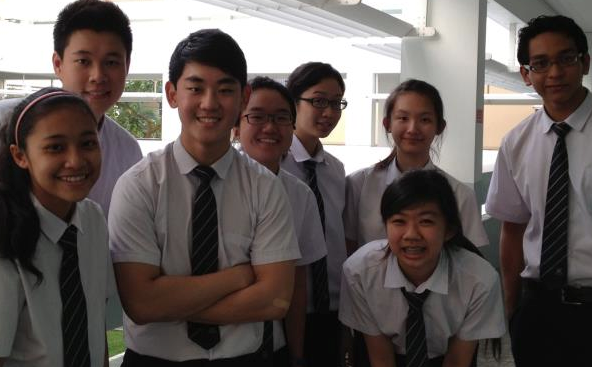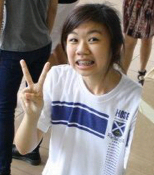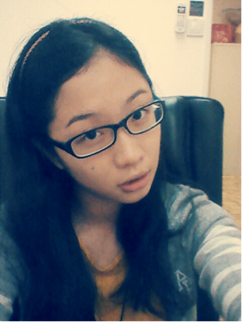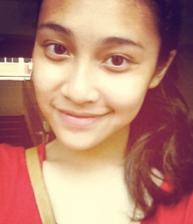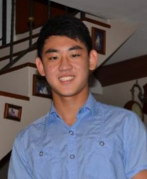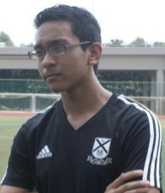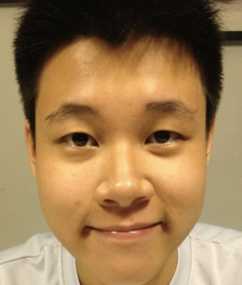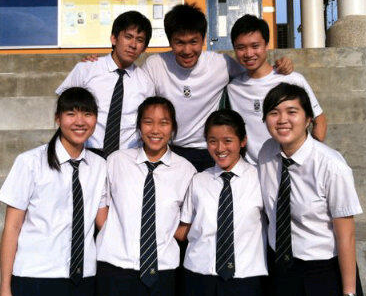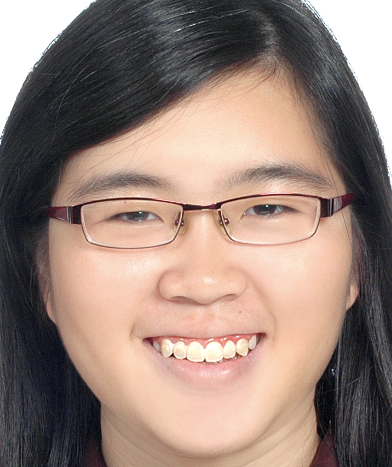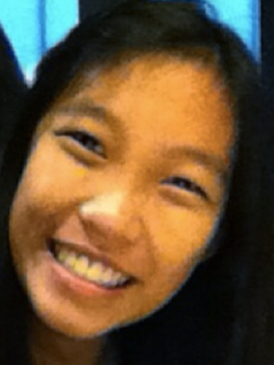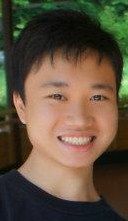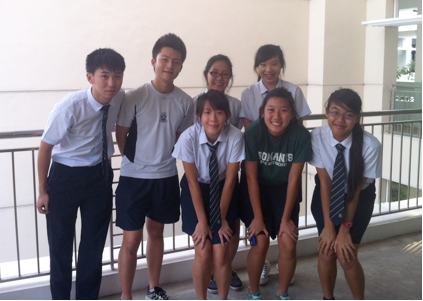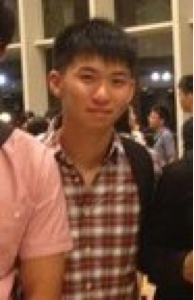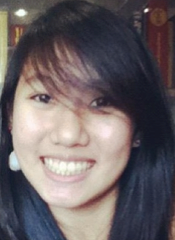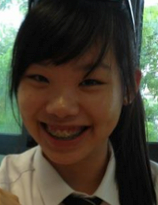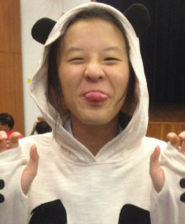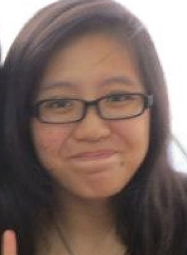Day 10 - Tate Modern/ Convent Garden/ Harrods/ Singapore
Tuesday, 4 December 2012, 06:18
Our last day in London
and we are all filled with different emotions. Some of us are already missing
Singapore, some of us cannot bear to leave London, some of us are excited and
some of us are sad. Regardless, we started day 10 by heading towards the Tate
Britain. In my opinion, the Tate Britain is a lot like a combination between
the National Gallery and Tate Modern. The Tate Britain was filled with all
types of artwork, from sculptures to contemporary works to different kinds of
paintings. The halls in the Tate Britain were really beautiful – large,
spacious and grand looking. In one of the rooms, there were many different
sketches on display and one of the most amazing things was that visitors were
encouraged to take a pencil and paper and sketch their own drawing and put them
on display. We were not invited to appreciate art, but also create our own
piece of artwork. It was a really inspiring activity.

 From the Tate Britain, we
then headed to Convent Garden for lunch and some shopping! Split into our
different groups, we all scattered into different directions, some heading to
places to shop while others looking for food. Some of us had our lunch at Gourmet
Burger Kitchen (GBK), now with more time to enjoy our meals. After our lunch,
we visited different shops around the area.
The coming Christmas season in Convent Garden reminded me a lot of
Orchard of Orchard Road in Singapore – beautiful decorations, plenty of shops
and bustling with activities. Later, we all gathered together with bags of
food, clothes and souvenirs. It was a delightful day indeed
From the Tate Britain, we
then headed to Convent Garden for lunch and some shopping! Split into our
different groups, we all scattered into different directions, some heading to
places to shop while others looking for food. Some of us had our lunch at Gourmet
Burger Kitchen (GBK), now with more time to enjoy our meals. After our lunch,
we visited different shops around the area.
The coming Christmas season in Convent Garden reminded me a lot of
Orchard of Orchard Road in Singapore – beautiful decorations, plenty of shops
and bustling with activities. Later, we all gathered together with bags of
food, clothes and souvenirs. It was a delightful day indeedSo what did we do for the rest of the day before our evening flight back home? We continued to shop till we drop! This time, we went to one of the most iconic area in London – Harrods. When people say you can get anything you want at Harrods, they are not kidding, trust me. Harrods was huge beyond believe and all that we saw was only from the ground level, not even the basement area. With such a huge crowd of visitors during this season and so many things on sale it was obvious that we did not have enough time to look through everything. However I am sure everyone came out of the store contented, bringing back all sorts of stuff we could get. According to our teachers, things such as pets and yachts can even be bought from Harrods. Unbelievable! What an amazing way to end our trip! One last look at this magnificent city and off we went to Heathrow airport for our flight back
Upon reaching Singapore,
many of us were welcomed home with family and friends waiting to pick us up at
the airport. Looking at all our faces, we really missed our family, friends and
our cozy beds. Our trip to London is indeed a wonderful adventure. We had
visited many museums, watched plays in the evenings, squeezed through the tube
and even tasted the food here in London.
Each one of these memories is indeed precious. Not only have we learnt
more about London and Singapore, I believe the friendship we have made was
unforgettable. All in all, Literary London was shiok!
Taking another break...
Sunday, 2 December 2012, 09:50
As we are about to take our return flight from London to Singapore, we will be unable to put up our blog post for day 10. We will put it up once we have arrived home. Sorry and thank you!
Day 09 - Borough Market/ Imperial War Museum
, 00:53
It was an especially cold morning, so some of us left the hotel bundled in seven layers of clothing! Even The Shard was shrouded in mist, a construct that holds claim to being Europe’s second tallest building at present. The Shard is also remarkably surrounded by old English architecture, making a walk through that part of London a truly magical experience where the new and old blend together to produce an experience that is uniquely London.
As we walked into Borough Market, we immediately felt as though we had stepped into a classical Charles Dickens novel. Bakers lined the streets selling a variety of bread ranging from white bread to grain bread and even low carb bread. Cheese makers accompanied these bakers and we saw huge wheels of cheese piled onto street stalls, all marked with names that were completely foreign to us.
Borough Market is broken into three different areas, the Green Market, Middle Market and Jubilee Market. The Green Market as its name suggests contained fruit and vegetable stores, but there was also an abundance of stalls selling chocolate and fudge. A sugar high was just what we needed to start our morning on a high note! Yet all that chocolate did not distract us from the fact that we were walking through London’s oldest fruit and vegetable market.
After Borough market we made our move to the Imperial War Museum. The building was originally used as a lunatic asylum, called the Bedlam Asylum. They have just begun refurbishment of the museum in preparations of the 100th anniversary of World War I that will be happening in 2014.
We had been given one hour before our guide, Sean, would arrive at the museum, so we took the opportunity to enjoy the peace of a nearby garden. Some of us even visited the playground and took turns using the swing!
We were broken up into our three groups once more when Sean arrived, to visit three different areas in the Imperial War Museum, the Lord Ashcroft Gallery, the Holocaust exhibit and finally the ‘Secret’ War exhibit.
Lord Ashcroft is an international businessman, author and philanthropist. He also holds the largest collection of Victoria Cross medals in the world and his gallery depicted stories of ultimate courage that has been displayed by British soldiers since the reign of Queen Victoria that began the tradition of awarding this medal of honor. The stories told there were inspirational to say the least, with examples such as one soldier who had jumped on a grenade to protect his company from the blast. A number of the medals had been awarded posthumously, to acknowledge those who had made the ultimate sacrifice of their lives in order to save others.
We then moved to the Holocaust exhibit, which brought us through World War II, showing the major events that began this global scale conflict and also the effects that it rained down on the population. This section was especially moving to us as they fully described the atrocities that were endured by the Jewish population, such as ‘Gas vans’ that were employed as mobile gas chambers as well as starvation that occurred in the ‘Ghettos’, where the Jews were confined to living in. The exhibit also opened our eyes to facts of the Nazi regime that had been unknown to us before, such as the “Euthanasia”, or mercy killing, of over 70000 Germans that had suffered from mental or physical disabilities.
Finishing our tours around the museum, we visited Brick Lane which is the Little Bangaldesh of London, for a Balti meal. Balti curries it is reputed originated not on the Indian sub-continent but in Britain, a product of the Indian communities who migrated to the northern counties of Britain, and that have now found their way back to the subcontinent. The naan and rice brought all of us back to the reality that this would be the last dinner in London and our trip was finally coming to an end.
With that somber mood we began our journey back to what had become home to us for the past 9 days. Leaving the tube that had brought us from London Bridge to Southwark, we said farewell to our last tube ride in London!
Written by Alexander 12A03 (Group A)
Day 08 - Singapore High Commission/ Poetry Workshop/ Victoria and Albert Museum
Saturday, 1 December 2012, 00:40
 The morning greeted us with the most astonishing weather forecast, that is, the temperature had dropped to 2 degrees Celsius. Apprehensive to leave the warmth of our hotel, we took a deep breath and swiftly headed to the underground with the TDP group where we alighted at Knightsbridge. Before heading to our first stop, the Singapore High Commissions, we rested at a nearby church St. Paul’s Church. Some of us rested in the church while others were taking photos with the TDP group.
The morning greeted us with the most astonishing weather forecast, that is, the temperature had dropped to 2 degrees Celsius. Apprehensive to leave the warmth of our hotel, we took a deep breath and swiftly headed to the underground with the TDP group where we alighted at Knightsbridge. Before heading to our first stop, the Singapore High Commissions, we rested at a nearby church St. Paul’s Church. Some of us rested in the church while others were taking photos with the TDP group. 
 When we reached the Singapore High Commissions (SHC), we reluctantly set foot into the building itself and initially thought that it would have been the most boring place that we would visit in London. As we settled down into the conference room, we were greeted by two friendly fellow Singaporeans, both who worked at the SHC. As they greeted us, I immediately felt the warmth of Singapore. The way they spoke and interacted with us was informal and their relaxed tone made us comfortable. The discussion revolved mainly on the diplomatic relations between Singapore and the UK. These include the economic position of Singapore and the UK as well as the main problems faced by the SHC when establishing and maintaining diplomatic relations. After the discussion, we proceed to have a small break where we had a chance to taste our own local delicacies such as the Nonya Kueh. It felt like a little taste of home when we ate the food. Overall, the visit was fruitful and felt like a short escape back to our very own hometown, Singapore.
When we reached the Singapore High Commissions (SHC), we reluctantly set foot into the building itself and initially thought that it would have been the most boring place that we would visit in London. As we settled down into the conference room, we were greeted by two friendly fellow Singaporeans, both who worked at the SHC. As they greeted us, I immediately felt the warmth of Singapore. The way they spoke and interacted with us was informal and their relaxed tone made us comfortable. The discussion revolved mainly on the diplomatic relations between Singapore and the UK. These include the economic position of Singapore and the UK as well as the main problems faced by the SHC when establishing and maintaining diplomatic relations. After the discussion, we proceed to have a small break where we had a chance to taste our own local delicacies such as the Nonya Kueh. It felt like a little taste of home when we ate the food. Overall, the visit was fruitful and felt like a short escape back to our very own hometown, Singapore.

We broke off for a short lunch break after leaving SHC. Since most of us were already full from the food at the SHC, most of us spent time looking at books in Blackwells or relaxing with a cup of coffee in Starbucks. After the break, we headed to our second destination of the day, a small studio for a writing workshop. Jacob Sam – La Rose, a renowned poet conducted a poetry workshop with us. We started off by listening to him recite some of his very own poems. It mesmerized us and we could feel a slight sense of inspiration from him as he recited his poem. The poem “Gravity” caught my personal attention and I was drawn to it. I could relate to it because the subject matter of basketball and how it felt to play a game was something I myself had experienced. Being able to listen to a poem recited by its original poet was an honour and we felt extremely privilege to have experienced that ourselves. His recitation ended with resounding applause after which we then began the lesson proper. Jacob first conducted an activity with us, where we had to use our five senses to describe an emotion which we chose. This taught us to express our emotions in an extended manner and also compelled us to exercise our originality when conveying these emotions. Next, we then had to describe the word sky without using twenty words which were commonly used to describe it. At first, this activity proved to be extremely difficult for most of us. However, after gathering our thoughts, original ideas began to flow and we were able to describe the meaning of sky to each other. The workshop ended with a mini autograph session with Jacob. Under the inspiration of his poems, most of us ended up purchasing his poetry collections and get them autographed. In conclusion, the workshop was useful and provided us a deeper insight to writing or interpreting a poem is all about.
 Keeping track of the time, we quickly made our way to the Victoria and Albert Museum (V&A). Over there, we had the liberty to explore the museum on our own without being restricted by tour guides. As we set foot into the museum itself, we felt excited to see what V&A museum had in store for us. Even having seen countless other museums, we were not disappointed with the great variety of artworks in V&A museum. These ranged from classic painting styles to items in everyday life like clothes. One thing significant in the V&A museum was the different kind of fashionable clothes displayed in the South East Asia section. These fashions include the classic wear of olden times which were the long robes with plain colours as well as the modern clothes of traditional Cheong Sums. I was surprised that it featured artefacts from as recent as the 20th century, and the costumes were very recent. Other than fashion, the museum also had interesting items such as jewellery and sculptures of models with very unique poses. Seeing these sculptures sometimes put me off as I felt very awkward having to see naked sculptures. However, as I proceeded on, I began to appreciate the nakedness as the positions and expressions were more about form and not sexual. I realised how expressive these artworks were. In a nutshell, the V&A museum had an extremely fascinating collection and we enjoyed ourselves thoroughly during the visit.
Keeping track of the time, we quickly made our way to the Victoria and Albert Museum (V&A). Over there, we had the liberty to explore the museum on our own without being restricted by tour guides. As we set foot into the museum itself, we felt excited to see what V&A museum had in store for us. Even having seen countless other museums, we were not disappointed with the great variety of artworks in V&A museum. These ranged from classic painting styles to items in everyday life like clothes. One thing significant in the V&A museum was the different kind of fashionable clothes displayed in the South East Asia section. These fashions include the classic wear of olden times which were the long robes with plain colours as well as the modern clothes of traditional Cheong Sums. I was surprised that it featured artefacts from as recent as the 20th century, and the costumes were very recent. Other than fashion, the museum also had interesting items such as jewellery and sculptures of models with very unique poses. Seeing these sculptures sometimes put me off as I felt very awkward having to see naked sculptures. However, as I proceeded on, I began to appreciate the nakedness as the positions and expressions were more about form and not sexual. I realised how expressive these artworks were. In a nutshell, the V&A museum had an extremely fascinating collection and we enjoyed ourselves thoroughly during the visit.
As the night fell we ended today’s activity with a hearty three course meal in the restaurant called Browns. Some had starters that ranged from chicken liver to soup to smoked salmon to mains like steak pie and fish cakes. For dessert, we were able to try out their mouth-watering signature crème Brulee dessert. After eating dinner, we made our way back to Travelodge and had an early night.
Written by Caleb Chong 12S22 (Group C)
Day 07 - Oxford
Friday, 30 November 2012, 00:47
Day 07 – Oxford
Still in a zombie-like state, we set off bright and early today to catch the train to Oxford! During the one hour train ride most of us slept, some snored, but we still managed to catch glimpses of the beautiful English countryside. Rolling green fields dotted with quaint English cottages – what a refreshing sight after the metal and concrete jungle that is London!
 When we reached Oxford, we were met by Nuala Young, a former town councilwoman and our guide for today. Within the town hall, we were introduced to the rich history of Oxford and the beginnings of Oxford University. Oxford itself was first inhabited by the Romans, Anglo-Saxons and subsequently the Normans. The University started off as a group of poor British students who fled from Paris after being evicted from the country by King Philip, due to a feud with the English King. Over the years, a proper university developed with actual teaching existing since 1096. We discovered that Oxford originally had exams based on subject debates in which there was no set answer or standard to adhere to. While this trained students to fully justify their every claim, a proper standard was needed, thus written exams were set from 1800 onwards. The original type of education system was very intriguing to us because the concept of vocalising our arguments in a persuasive manner is quite foreign to us Singaporean students who are used to writing things down.
When we reached Oxford, we were met by Nuala Young, a former town councilwoman and our guide for today. Within the town hall, we were introduced to the rich history of Oxford and the beginnings of Oxford University. Oxford itself was first inhabited by the Romans, Anglo-Saxons and subsequently the Normans. The University started off as a group of poor British students who fled from Paris after being evicted from the country by King Philip, due to a feud with the English King. Over the years, a proper university developed with actual teaching existing since 1096. We discovered that Oxford originally had exams based on subject debates in which there was no set answer or standard to adhere to. While this trained students to fully justify their every claim, a proper standard was needed, thus written exams were set from 1800 onwards. The original type of education system was very intriguing to us because the concept of vocalising our arguments in a persuasive manner is quite foreign to us Singaporean students who are used to writing things down.
After breaking for a warm lunch in the town’s covered market, we headed off for a walking tour of the Oxford University and its colleges. Oxford University has 38 colleges, out of which we visited one - the famous Christchurch College. Christchurch is not the oldest college (Merton College is) but it is one of the most prolific and impressive in terms of architecture. It is the only college that houses a cathedral! It was lovely to walk around the compound and soak in the view, especially with the sun shining on us and warming our frozen bodies. Although there are currently only 206 Singaporean students in Oxford, I hope that the number will expand and that our Saints will be amongst that number.
On our tour, we saw some of the areas in which the Harry Potter movies were filmed, such as the Great Hall that was inspired by the dining hall in Christchurch or the wide stone staircases of Christchurch College that became the staircases in Hogwarts. Many of us Harry Potter fans were thrilled to be there at the actual filming locations and some of us were even tempted to sit at the dining hall and pretend we were feasting in Hogwarts!
We discovered that Christchurch was the college of many famous people including W.H Auden and Lewis Carroll. In fact, Lewis Carroll’s book Alice’s Adventures in Wonderland, were inspired by his surroundings and experiences in Oxford. His book was based on stories he had told the dean’s daughter, Alice, and many of his other characters were also inspired by real-life people he met in Oxford! Some speculate that the Hare was inspired by the dean himself who often rushed to attend service in the Cathedral through a secret door, much like the Hare in the book. It was very interesting to see the inspirations behind such a magical book and I think many of us will be able to appreciate it better as a result.

To end off the day, we went for a hearty dinner at the Beefeaters Grill though many of us didn’t actually eat beef. Some had risotto, grilled chicken and even salmon. It was a good meal and it would’ve been a good end to the day if we our train ride home hadn’t been cancelled unexpectedly! Thus we had to wait for a later train, and this left us secretly cursing the British railway system. However, it also made us realize that Singapore’s MRT wasn’t all that bad and it ma de us more appreciative of our relatively reliable train system.
Day 06: Globe Theatre/Tate Modern/Richard III
, 00:32
The day started out with two battles: the first was us fighting for space and food during breakfast against the two other school groups staying at our Travelodge (one of which is the TDP group!), and the second battle was against the bitingly cold wind that hit us the second we stepped out of the Travelodge and throughout the half an hour debrief with the teachers at vacant benches across the road belonging to a pub that was still closed at that time. The temperature that day was around 5 degrees, and Ms K warned us that it was going to drop further as the week progressed. Some of us are hoping and excited for it to possibly start snowing, while others are hoping it won’t. The debrief proceeded with Gillian, Edmund, Eunice and Marcus presenting on the British Legal System and the Globe Theatre.

 After which, we walked to the Millennium bridge over the River Thames, which apparently started swaying when people were walking across the first time it was opened to the public. Reconstruction was done, although it took another 18 months before the bridge opened to the public again. Thankfully, the bridge felt very steady as we hurried across, with our heads kept low and hands tucked into our pockets to brace against the icy wind. It had breathtakingly beautiful views, which meant group photos were in order. We then headed to St. Paul’s Cathedral which was located right in front of the bridge, where we sat on the stone steps leading to its entrance to listen to Dawn present on its history as well as kept a watchful eye on the fat London pigeons that were much more unafraid of humans than the Singapore ones were. We were then given an half hour’s break to find somewhere warm to rest and get much needed hot drinks or snacks
After which, we walked to the Millennium bridge over the River Thames, which apparently started swaying when people were walking across the first time it was opened to the public. Reconstruction was done, although it took another 18 months before the bridge opened to the public again. Thankfully, the bridge felt very steady as we hurried across, with our heads kept low and hands tucked into our pockets to brace against the icy wind. It had breathtakingly beautiful views, which meant group photos were in order. We then headed to St. Paul’s Cathedral which was located right in front of the bridge, where we sat on the stone steps leading to its entrance to listen to Dawn present on its history as well as kept a watchful eye on the fat London pigeons that were much more unafraid of humans than the Singapore ones were. We were then given an half hour’s break to find somewhere warm to rest and get much needed hot drinks or snacks
We then headed back across the Bridge to go to the Globe Theatre that was right next to the Millennium Bridge. One of the actors - Chu - met us and brought us inside the Globe where he shared with us the Globe’s history. Back then, the Globe was the most popular theatre in the Elizabethan times as the outdoor structure of the theatre made tickets relatively cheaper than the other indoor theatres. The Globe’s circular structure of where the audience sat affected how plays were staged, as it was required for the actors to move around the stage a lot to address the entire audience from all angles. This meant that plays (especially Shakespeare’s), were written with the structure of the Globe in mind, which is interesting as this is the opposite from the norm in today’s modern plays where the stage has to adapt according to the play. Since the Globe’s stage is completely bare from any lighting, speakers, or elaborate sets, everything the audience needed to know about the play’s setting had to be revealed in the character’s dialogue with each other.
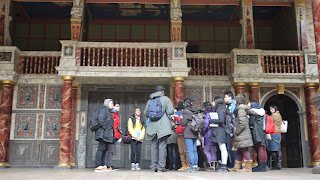 We were then brought up to the stage to see up close the two entrance doors at the back of the stage, and the two trap doors located in the middle of the ceiling and the floor. Fascinatingly, we were told that the entrance door located stage left is usually where the sinister characters entered from because “left” means “sinister” in Latin. The entrance door at stage right is hence where the righteous characters entered from at the start of the play. This was so that the audience would know immediately when the characters entered on stage whether they were the heroes or villains of the play. Furthermore, the trapdoor located on the ceiling represented “heaven”, as seen in the beautiful paintings of stars and the zodiac, and the trapdoor on the floor thus represented “hell”.
We were then brought up to the stage to see up close the two entrance doors at the back of the stage, and the two trap doors located in the middle of the ceiling and the floor. Fascinatingly, we were told that the entrance door located stage left is usually where the sinister characters entered from because “left” means “sinister” in Latin. The entrance door at stage right is hence where the righteous characters entered from at the start of the play. This was so that the audience would know immediately when the characters entered on stage whether they were the heroes or villains of the play. Furthermore, the trapdoor located on the ceiling represented “heaven”, as seen in the beautiful paintings of stars and the zodiac, and the trapdoor on the floor thus represented “hell”.
We then took a quick one hour break to grab a bite to eat as well as to visit the Globe exhibition. The exhibition showcased the history of the Globe Theatre and the changes to its structure as it went through reconstructions. It also featured the life of Shakespeare and his works in relation to the events that were happening in London at the same time. An interesting section was at the end, where a lady showed us the exact machine and method that was used in Shakespeare’s time to print the plays. It was an extremely complicated process where every word had to be slotted into a metal casing letter by letter, and each letter piece was stored in cases. This was where the term ‘uppercase’ and ‘lowercase’ came from, as the capital letters were literally stored in the upper case, and the small letters stored in the lower case. The lady demonstrated to us as well how the pressing machine was used to print the inked lettering onto a piece of paper. The entire process looked long and tedious, but we were told that the people hired to print required 7 years of training for this job, and that they could expertly slot in letter and print pages by pages with extreme effectiveness and speed.
 Following the break was our drama workshop, where we participated in simple activities that required us to communicate with each other, like how actors have to when they first met up for rehearsals. We were taught that communication took place in 3 ways: through voice, eye contact, and imagination. We were also taught iambic pentameter, the rhythmic structure that Shakespeare used when writing his plays. It usually consists of ten syllables in each line, with a total of 14 lines. It follows a ‘stressed, unstressed’ pattern when spoken, which is supposed to mimic a human heartbeat. We practiced speaking parts of Shakespeare’s Othello, and had to act out the lines to our partners. Although we found it humorous at the start, it was an eye-opener for most of us on how Shakespearean plays are acted out. We also learnt how the status of a character is dependent on how he/she treats others and how he/she is treated by others, helping us to understand Shakespeare plays better when we next watch one.
Following the break was our drama workshop, where we participated in simple activities that required us to communicate with each other, like how actors have to when they first met up for rehearsals. We were taught that communication took place in 3 ways: through voice, eye contact, and imagination. We were also taught iambic pentameter, the rhythmic structure that Shakespeare used when writing his plays. It usually consists of ten syllables in each line, with a total of 14 lines. It follows a ‘stressed, unstressed’ pattern when spoken, which is supposed to mimic a human heartbeat. We practiced speaking parts of Shakespeare’s Othello, and had to act out the lines to our partners. Although we found it humorous at the start, it was an eye-opener for most of us on how Shakespearean plays are acted out. We also learnt how the status of a character is dependent on how he/she treats others and how he/she is treated by others, helping us to understand Shakespeare plays better when we next watch one.
After that fun session, we proceeded to the Tate Modern located nearby. We were accompanied by Sean, who informed us that the Tate Modern was opened in 2000, in the former Bankside Power Station, and holds modern artworks that date throughout the 20th century. It is the most successful art gallery with around 5 million visitors a year, and contains artworks of various artistic styles such as surrealism, photomontage, realism, sculpture, etc. He brought us through a few artworks to introduce to us examples of the various art styles that was hugely popular to artists in the 20th century, the famous Pablo Picasso being one of them. We were then given time to browse through the gallery ourselves and do our reflections on a piece we chose. Personally, it was fascinating looking at how art has developed into so many different styles other than painting, but still used as a form of expression to convey the message of an artist to his/her audience.
We eventually left for dinner at Rock. Sole and Plaice to have the famous British fish and chips. The portion sizes were big and immensely satisfying, and we left for Richard III stuffed and happy.
Richard III was held at Apollo Theatre, where we were seated in the circle stalls with restricted view of almost half the stage. Nevertheless, we could see right from the start that the stage was set exactly as it would be in the Globe Theatre. There were seats for audience to sit on either side of the stage, and there were no light changes, black outs, or curtain closing. The actors addressed all sides of the stage, just like what our Globe guide told us how they would. I was surprised to find out during the play that Richard III was humorous. It wouldn’t seem that way by just reading the text, but by the way the actor acted out his lines that made the jokes more obvious. It showed how important watching plays is so supplement what we study in the text, as Shakespeare plays were always meant to be watched and heard instead of read. It was hard to decipher the Shakespearean language spoken by the actors in time to what they were saying however, which made concentrating difficult for the entire three hours of the play. All in all, the play and the actors were spectacular, and it made me eager to watch Othello (the text we are currently studying), to be able to fully grasp how the play is supposed to be performed, and the impacts it has to the audience.
Along the trip back to the Travelodge, a few of us lucky ones managed to see Sir Ian McKellen as he passed us by on his way out of the theatre! He smiled at us and we were unfortunately too stunned and in awe to ask for a picture and autograph.. Another celebrity encounter was the day before, after watching War Horse, where lucky Christian was calm enough to ask and obtain Jamie Oliver’s autograph!
It was definitely an extremely eventful day for all of us, and we finally reached our Travelodge exhausted yet excited for our trip to Oxford the next day. Maybe we would meet some more celebrities?
Gabrielle Goh, 12A06
Taking a break...
Wednesday, 28 November 2012, 16:03
Just a short notice to say sadly we won't be posting today because we've been having late nights watching really good plays. Hence, there will be two posts going up tomorrow for Day 6 and Day 7!




















